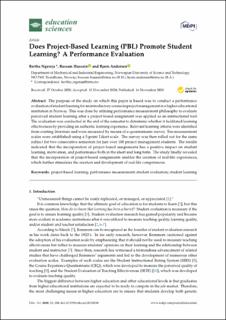| dc.contributor.author | Ngereja, Bertha Joseph | |
| dc.contributor.author | Hussein, Bassam | |
| dc.contributor.author | Andersen, Bjørn Sørskot | |
| dc.date.accessioned | 2021-09-22T07:08:57Z | |
| dc.date.available | 2021-09-22T07:08:57Z | |
| dc.date.created | 2020-11-16T13:50:19Z | |
| dc.date.issued | 2020 | |
| dc.identifier.citation | Education Sciences. 2020, 10 (11), . | en_US |
| dc.identifier.issn | 2227-7102 | |
| dc.identifier.uri | https://hdl.handle.net/11250/2780221 | |
| dc.description.abstract | The purpose of the study on which this paper is based was to conduct a performance evaluation of student learning for an introductory course in project management in a higher educational institution in Norway. This was done by utilizing performance measurement philosophy to evaluate perceived student learning after a project-based assignment was applied as an instructional tool. The evaluation was conducted at the end of the semester to determine whether it facilitated learning effectiveness by providing an authentic learning experience. Relevant learning criteria were identified from existing literature and were measured by means of a questionnaire survey. Ten measurement scales were established using a 5-point Likert scale. The survey was then rolled out for the same subject for two consecutive semesters for just over 100 project management students. The results indicated that the incorporation of project-based assignments has a positive impact on student learning, motivation, and performance both in the short and long term. The study finally revealed that the incorporation of project-based assignments enables the creation of real-life experiences, which further stimulates the creation and development of real-life competencies. | en_US |
| dc.language.iso | eng | en_US |
| dc.publisher | MDPI | en_US |
| dc.rights | Navngivelse 4.0 Internasjonal | * |
| dc.rights.uri | http://creativecommons.org/licenses/by/4.0/deed.no | * |
| dc.subject | project-based learning; performance measurement; student evaluation; student learning | en_US |
| dc.title | Does Project-Based Learning (PBL) Promote Student Learning? A Performance Evaluation | en_US |
| dc.type | Journal article | en_US |
| dc.type | Peer reviewed | en_US |
| dc.description.version | publishedVersion | en_US |
| dc.source.pagenumber | 15 | en_US |
| dc.source.volume | 10 | en_US |
| dc.source.journal | Education Sciences | en_US |
| dc.source.issue | 11 | en_US |
| dc.identifier.doi | 10.3390/educsci10110330 | |
| dc.identifier.cristin | 1848357 | |
| cristin.ispublished | true | |
| cristin.fulltext | original | |
| cristin.qualitycode | 1 | |

